Both of my parents were pharmacists who qualified in the 1940s. Their training involved years of study of the medicinal properties of plants and minerals and the hands-on making up of compounds now lost to memory. It included the memorisation for exams, both practical and written, of hundreds of compounds in Latin.
It was a world rooted in Latin taxonomies and classifications of illnesses, the body, its organs and functions that went back to the known world of the medieval apothecary. In my parents’ day this was already ceding ground to the modern pharmaceutical world of drugs and medicines manufactured by drug companies. The company my father worked for, Schering AG Berlin, made something beyond the compounding powers of the apothecaries: the contraceptive pill.

Visiting me in the 1990s my father was aghast to see on a shelf in my kitchen a bottle labelled Belladonna. Despite its oh-so-pretty name Belladonna is one of the most toxic poisons in nature. I tried to reassure him with what I knew (pathetically little) of homeopathy. Any amount of Belladonna was too much in the wrong hands. Mine in other words. It was poison. End of story. He was so agitated that I promised to get rid of it.
There was no Dr Google then but a very cursory search under Belladonna today will reveal a long list of terrifying old names for the plant, Devils Berries, Deadly Nightshade and so on. Its Latin name, Atropa Belladonna, hints at its fatal properties; Atropos was one of the three Fates who cut the cord of life. However, the search also throws up a slew of material promoting the myriad benefits of Belladonna and products which contain it from teething gels to plasters. How is anyone to process this welter of information and make decisions on foot of it? How are we to know what to believe? What informs the decisions we make and what sources or whom do we trust?
The Known World is a heading found on ancient maps drawn by the earliest cartographers. These maps relied on the experience of explorers who had been to the regions described; they often included some speculation about what lay beyond the charted territories. Implied in the title was the idea that there was much of the world that was unknown or yet to be known. Further exploration would gradually fill in but never quite complete the map.
Almost every public issue generates contested narratives pitting lived experience or personal belief systems against the expert opinion or the evidence as officially presented.
This pattern of setting out in a given direction with an existing map, exploring and charting new territory (sometimes incorrectly like Columbus) could be understood as a metaphor for how our knowledge of the world has been built up. Even when what has been posited goes wildly against the status quo the expert account backed by verifiable evidence usually becomes the accepted account of the known world to be replaced or added to in the future. With knowledge comes understanding. Or does it?
In our time the anxieties, fears and anger engendered by an endless succession of public scandals produced cataclysmic ruptures in public belief and trust which provided an ominous backdrop for the Covid-19 pandemic. Early on the WHO identified the “infodemic” as being as dangerous a foe in the fight against Covid-19 as the disease itself.
Distrust
The trouble was that the “known world” in this context was and still is evolving. It is very slowly coming into view whilst the 24/7 instantaneous “known” world is outpacing it.
In August 2020, 46 per cent of Americans reported that they would prefer to take advice from family members before accepting the vaccine, compared with 43 per cent who would first refer to the Center For Disease Control.
Contradictory advice from public sources around masks, ventilation, staying indoors, mixed messages about lockdowns and abrupt about-turns in Covid management policies made inroads into public trust and general fearfulness about making decisions.
Distrust of medical and public health experts has deep roots and predates Covid. The controversy around the MMR vaccine and the now discredited belief that it caused autism has set back vaccination programmes, mainly in the developed world. Education has also been shown not to have any ameliorating effect. Vaccination resistance rates are high amongst the highly educated. This presents a radically new challenge to the scientific community and public policy makers because it is resistant to factual scientific explanation.
The general suspicion of all kinds of expertise in the west has played out in this country across a range of issues, from climate change to 5G to the mother and baby homes commission report. Amplified by social media and the internet, almost every public issue generates contested narratives pitting lived experience or personal belief systems against the expert opinion or the evidence as officially presented.
Indeed Ireland’s history, or Irish history itself, could be said to be made up of a series of contested narratives, of official versions and records, of memoirs and stories and accounts which refuse to match up.
Ancient cartographers accepted the limits imposed on them by time and technology and of the unfixed indeterminate nature of their particular maps. They point us to a different place from where it could be possible to move towards accepting uncertainty with a belief in our ability to extend our knowledge and share our understanding of the world.
The Known World – What We Know Now will be streamed at 7pm on Tuesday, June 22 https://www.youtube.com/user/othervoiceslive









